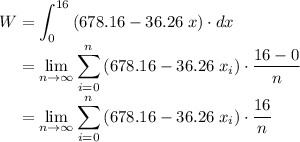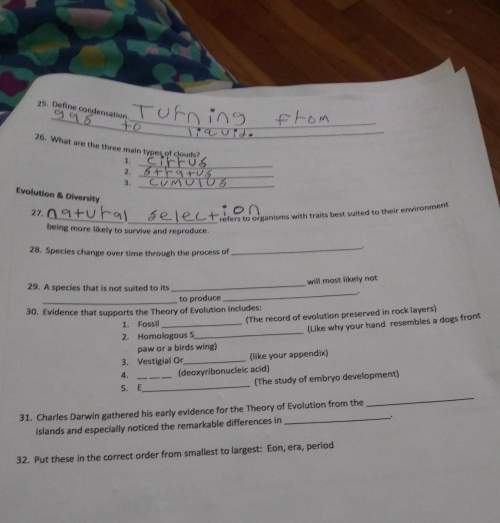
Aleaky 10-kg bucket is lifted from the ground to a height of 16 m at a constant speed with a rope that weighs 0.7 kg/m. initially the bucket contains 48 kg of water, but the water leaks at a constant rate and finishes draining just as the bucket reaches the 16-m level. find the work done. (use 9.8 m/s2 for g.) show how to approximate the required work by a riemann sum. (let x be the height in meters above the ground. enter xi* as xi.)

Answers: 3


Another question on Physics

Physics, 22.06.2019 05:40
Karen is running forward at a speed of 9 m/s. she tosses her sweaty headband backward at a speed of 20 m/s. the speed of the headband, to the nearest whole number relative to a stationary observer watching karen
Answers: 1

Physics, 22.06.2019 07:00
We have a colorless transparent liquid. it looks like water. we seperated it into a solid and a liquid by evaporration and condention was this a chemichal or a physical seperation a. chemical seperation b. physical seperation
Answers: 3

Physics, 22.06.2019 17:00
In the future, people will only enjoy one sport: electrodisc. in this sport, you gain points when you cause metallic discs hovering on a field to exchange charge. you are an electrodisc player playing the popular four disc variant. the disks have charges of qa = −8.0 µc, qb = −2.0 µc, qc = +5.0 µc, and qd = +12.0 µc. (1) you bring two disks together and then separate them. you measure the resulting charge of these two disks and find that it is +5.0 µc per disk. which two disks did you bring together? (a) a and b (b) a and c (c)a and d (d)b and c(e) b and d (f) c and d. (2) you bring three disks together and then separate them. you measure the resulting charge of these three disks and find that it is +3.0 µc per disk. which three disks did you bring together? a, b, and c (a) a, b, and d (c) a, c, and d (d) b, c, and d. (3) given the resulting charge of each disk measured in (b) is +3.0 µc, how many electrons would you need to add to a disk of this charge to electrically neutralize it? electrons
Answers: 3

Physics, 22.06.2019 19:30
Amass m = 74 kg slides on a frictionless track that has a drop, followed by a loop-the-loop with radius r = 18.4 m and finally a flat straight section at the same height as the center of the loop (18.4 m off the ground). since the mass would not make it around the loop if released from the height of the top of the loop (do you know why? ) it must be released above the top of the loop-the-loop height. (assume the mass never leaves the smooth track at any point on its path.) 1. what is the minimum speed the block must have at the top of the loop to make it around the loop-the-loop without leaving the track? 2. what height above the ground must the mass begin to make it around the loop-the-loop? 3. if the mass has just enough speed to make it around the loop without leaving the track, what will its speed be at the bottom of the loop? 4. if the mass has just enough speed to make it around the loop without leaving the track, what is its speed at the final flat level (18.4 m off the ground)? 5. now a spring with spring constant k = 15600 n/m is used on the final flat surface to stop the mass. how far does the spring compress?
Answers: 3
You know the right answer?
Aleaky 10-kg bucket is lifted from the ground to a height of 16 m at a constant speed with a rope th...
Questions








Mathematics, 27.05.2020 11:58



Mathematics, 27.05.2020 11:58

Mathematics, 27.05.2020 11:58

Chemistry, 27.05.2020 11:58

Mathematics, 27.05.2020 11:58



Geography, 27.05.2020 11:58

English, 27.05.2020 11:58

Mathematics, 27.05.2020 11:58

 .
. and the mass of the water in the bucket
and the mass of the water in the bucket  varies with the height
varies with the height  of the bucket. Express the two masses as a function of
of the bucket. Express the two masses as a function of  ,
, . The mass of the water left in the bucket at height
. The mass of the water left in the bucket at height  .
. . Combining the three:
. Combining the three: .
. .
. .
. .
. .
.


